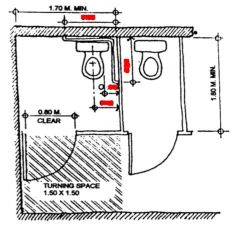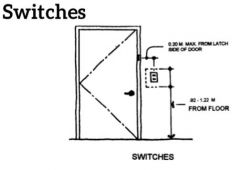Pwd Parking Slot Dimension
The minimum specification for disabled parking: You must provide a minimum of at least 1 disabled car parking space per 20 parking spaces. If you have less than 20 parking spaces you must provide 1 disabled parking space. Where physically possible allocate 4-6% of your available parking spaces for disabled people. The bill proposes to require public establishments to provide at least one PWD slot for every 25 parking spaces, and that this slot should be clearly marked and display the minimum penalty as prescribed by law. Only those with a government-issued PWD sign can use this parking slot. They see the wheelchair symbol, and they know what it means.
1. PROBLEM IDENTIFICATION
Poor parking facilities.
Insufficient width of the parking aisle.
No allocation of parking space for the disabled.
2. PLANNING PRINCIPLE
To provide accessible parking facilities as close as possible to the point of destination.
3. DESIGN CONSIDERATIONS
3.1 General
Accessible parking provisions apply to both outdoor and underground facilities.
For multi-storey indoor parking facilities, at least one level should be served by an accessible elevator.
3.2 Number
For parking facilities of less than 50 cars, at least one accessible parking space should be provided in every parking facility.
For parking facilities of a maximum number of 400 spaces, accessible parking spaces should at least be provided in the ratio of 1:50 (one accessible space for every 50 spaces).
For parking facilities of more than 400 spaces, at least 8 accessible parking spaces should be provided plus 1 space for each additional increment of 100 cars over 400.
3.3 Location
For outdoor parking, accessible parking spaces should be located not more than 50 m from accessible building entrances.
For indoor parking, accessible parking spaces should be located right next to accessible elevators, or as close as possible to exits.
The ends of rows are preferable for vans with lifts for wheelchair users.
3.4 Dimensions
The minimum width of an accessible parking space is 3.60 m. The recommended width is 3.90 m (fig. 1).
An access aisle 1.20 m wide can be located between two ordinary parking spaces (fig. 2).
For indoor parking, the minimum height clearance for vans with hydraulic lifts is 2.40 m.
Where parking spaces are angled, the extra space at the end of a row can be used as a parking aisle for disabled persons (fig. 3). 3.5 Parking curb
If a curb exists, curb ramps should be provided to link accessible parking spaces to accessible pathways (fig. 2).
If no curb exists, a textured surface at least 0.60 m wide is needed to separate the pathway from the vehicular area; otherwise bollards should be used (see Street Furniture). Pre-cast wheelstops can also be used to set apart a passage at least 0.90 m wide (fig. 4) (fig. 5).
3.6 Curbside parking
Curbside parking is dangerous for disabled people unless it is designed as an accessible drop-off area.
Pwd Parking Slot Dimensions Meters
3.7 Drop-off areas (fig. 6)
Drop-off areas are beneficial for picking up and dropping off people with physical limitations, parents with children, people carrying loads, etc.
Drop-off zones should be provided at public transport stops such as bus stops, and not more than 30.00 m from accessible building entrances.
The drop-off area should be at least be 3.60 m wide and incorporate an aisle 1.20 m wide to allow for manoeuvring. The length should accommodate at least two cars.
Appropriate curb ramps should be provided to facilitate circulation over paved surfaces.
Pwd Parking Slot Dimension
Where no curb exists to mark the separation between pedestrian and vehicle zones, the installation of a cue is necessary to guide sightless pedestrians:
(a) Bollards may be used (see Street Furniture); (b) A tactile marking strip at least 0.60 m wide can be constructed at the edge of the pathway to warn of the transition to a vehicular area.
Pwd Parking Slot Dimensions
A protected shelter or canopy with seating facilities is a recommended design feature at passenger loading zones.

Signs should be installed to identify a drop-off zone and prevent its misuse as a parking space.
3.8 Surface
The surface of a parking facility should beuniform and smooth.
The slope of a parking ramp should not exceed 1:20.
3.9 Signs (fig. 7)
Accessible parking areas should be marked by the international symbol of accessibility. (1)
4. EXISTING CONSTRUCTIONS


If the parking area is more than 50.00 m from the building entrance, a vehicular drop-off area within 30.00 m of the entrance should be built or an accessible parking space close to the entrance should be constructed.
If no accessible parking space is available, one of the following measures should be implemented:
(a) Block a peripheral regular stall with bollards to get one accessible parking space (fig. 8).
(b) Block a central regular stall with bollards to get two accessible parking spaces (fig. 9).
(c) Two accessible parking aisles (fig. 9).
For indoor parking spaces with clear height of less than 2.40 m, alternative outdoor provisions for vans carrying disabled people should be provided.
Notes:
(1) An exacting fine can be imposed on non-disabled drivers who park in a parking space designated for the disabled.
Driving requires a lot of skills. One of which is parking — be it parallel or not. But more importantly, a driver should know and be aware of where and when to park properly. This article will discuss common guidelines and whatnots about parking and its corresponding consequences or fines if not followed.
Driveway or public road parking
The rule of thumb is to always park one meter away from a vehicle entrance. Failure to do so makes it difficult for drivers in larger vehicles to get in and out of the driveway. It will also cause blocking emergency services. If this happens to you, you have the right to complain to a traffic officer or local council, who will also be the deciding body whether to issue a ticket to the driver and/or tow the vehicle.
Metropolitan Manila Development Authority or MMDA is widely known as the Philippines’ traffic commission who is in charge for any traffic violators. In 2002, MMDA released a memorandum order under Resolution No. 02-33 that states,
“MMC Ordinance No. 78-03 as amended, authorizes the Metropolitan Manila Development Authority to tow and impound illegally parked vehicles.”
As the memorandum clearly stated, no one is exempted in the towing so long as you did an illegal park. The memo also includes the two guidelines to when a vehicle could be towed. These are as follows:
- “Stalled Vehicle” means any motor vehicle and/or its attachments which for any cause is unable to proceed under its own motive power and is on a public road, street or thoroughfare and dilapidated/junked vehicles in Metro Manila.
- “Illegally Parked Vehicle” refers to one which is parked in areas prohibited by existing law or ordinance for parking purposes or those designated by the Authority and or the local government units (LGUs) as NO PARKING areas or zones.
To further guide you on your next parking, below are other basic parking mishaps that you should avoid.
Pavement parking
This type of careless parking is when a vehicle is causing obstruction to pedestrians, having them step off the pavement and walking towards the highway which is absolutely dangerous. Pavement parking makes it difficult as well for people with disabilities (especially those on wheelchairs) to pass safely. If you own the pavement, then you will automatically be exempted to the rule.
Outside the line parking
Parking lines are created to ensure that each vehicle has enough space to get in and out of the vehicle. It is a must to ensure that you park your vehicle within the given area to avoid double parking (using two parking slots). This technically eats up space that lessens opportunity for others who badly need to park as well. To avoid making this mistake, make sure that all your wheels are within the parking line. As easy as that.
Yellow line parking
Ever wonder what’s the purpose of yellow lines in car parks? Yellow lines mainly indicates restrictions in parking areas depending on the location you are at.
There are two types of yellow line in car parks:
- Single yellow line – restrictions on parking is only for a short period of time and these restriction periods are shown by a signpost.
- Double yellow line – 24/7 restriction and signposts are not needed.
Yellow double lines are popularly used in Singapore, United Kingdom, and United States.
Parking on PWD (people with disability) slot
As respect and help to people with disabilities, all parking areas around the world are required to have a slot or bay for them. In the Philippines this is clearly defined in the IRR of BP 344 entitled “AN ACT TO ENHANCE THE MOBILITY OF DISABLED PERSONS
BY REQUIRING CERTAIN BUILDINGS, INSTITUTIONS, ESTABLISHMENTS AND PUBLIC UTILITIES TO INSTALL FACILITIES AND OTHER DEVICES.” This slot is easy to recognize since it has a drawing of a stick man that seems to sit on a wheelchair. Also, PWD slots are always located near the entrance of establishments. Even if the slot doesn’t have a vehicle parked on it, it doesn’t give you any permission to park there unless if you’re a person with a disability yourself. Always remember that good and responsible parking reflects a good driver after all.
If you’re someone who wants to know who gets to use the PWD parking then you can check-out this article.

Carlos is a digital marketing and lead generation expert who has helped advocate driver education websites since 2012.